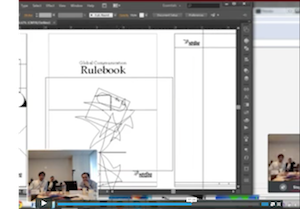Jan 06
2015
0
comments
3 Tips for Collaborating with Global Creative Talents
 Have you ever collaborated with a creative person who is overseas, say a web designer in India, and the whole experience turned out to be a nightmare?
Have you ever collaborated with a creative person who is overseas, say a web designer in India, and the whole experience turned out to be a nightmare?Working globally with creatives is challenging. Why? Because communicating with them is difficult. Creatives communicate and think differently than we business people do. And if you fail to connect with them and tap into their creativity, you’ll end up doing most of the work and producing a mediocre design/product. In today’s environment, the complexity multiplies since you will most likely be working with someone who is a non-native English speaker in a virtual setting (e.g. via Skype).
The final session of one of my recent corporate training courses clearly showed what happens when things go well, and what happens they don’t. At the end of an 8-week Global Communication course, the fifteen participants were split into three groups, and each group had ninety minutes to work with a web designer via Skype to produce a cover for a communication guidebook developed during the course. The designers, from the Ukraine, the Philippines and Bangladesh, were hired via oDesk, a global outsourcing service.
Watching the videos of each group working with its designer was eye-opening, and the key learnings went much deeper than just designing a cover. In fact, I found that they apply to virtually any project that requires collaborating globally with creative people:
- Find the right talent
Hiring the right person should always be the top priority. Keep looking till you do. Never compromise. Pay close attention to:
Past work
Is the work in his/her portfolio similar to what you are looking for?
Ability to communicate
How hard does he/she try to truly understand what you’re saying?
Chemistry
Do you feel it? If you feel uncomfortable in any way, that is not the right person.
- Let the artist use his creativity
 If a web designer relies on his creativity for a living, why not fully include him in the creative process? Some groups didn’t even try to convey the essence of the their ideas. They brainstormed without involving the artist and became fixated with their own idea, leaving very little room for input from the artist.
If a web designer relies on his creativity for a living, why not fully include him in the creative process? Some groups didn’t even try to convey the essence of the their ideas. They brainstormed without involving the artist and became fixated with their own idea, leaving very little room for input from the artist.
They just told the web designer what they wanted (or rather, what they thought they wanted) and how to do it, and the designer did his best to comply.In the most successful group, all participants quickly figured out how to bond. They made the artist feel comfortable and a part of the group so that he could demonstrate and fully use his skills.
- Be sure the artist grasps what is being conveyed
Does the artist constantly clarify so that you are both sure that he understands what you are saying? Even if the group involved the artist from the beginning, communication issues were a big factor. Successful groups constantly engaged the artist, and the artist constantly confirmed that he understood. They used screen sharing features and they drew images on paper and showed them via the video. In other words, they used every medium available to convey their ideas.
If you hire the right person, let the artist use his creativity, and make sure the artist grasps what you are conveying, you’ll end up doing a lot less work and producing a first-rate design/product.

